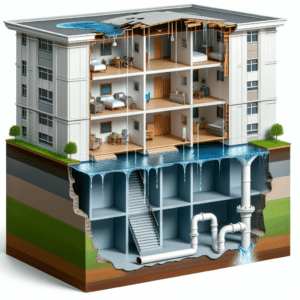What is Environmental Mold Testing?
Environmental mold testing is the process of collecting samples of indoor air, surfaces, and materials to determine the presence and type of mold in a building. These tests are conducted by certified mold inspectors using specialized equipment and techniques to identify potential mold growth and assess its potential health risks.
Why is Mold Testing Important?
Mold is a type of fungus that can grow and thrive in damp and humid environments. It releases spores into the air, which can cause a variety of health issues in humans, including allergies, respiratory problems, and skin irritation. Mold growth can also damage the structure of a building and lead to costly repairs.
By conducting environmental mold testing, you can identify the presence of mold in your home or office and take necessary steps to get rid of it before it poses serious health risks or causes extensive damage.
The Benefits of Environmental Mold Testing
Early Detection of Mold Growth
The most significant benefit of environmental mold testing is that it enables you to detect mold growth early on. As mold spores are invisible to the naked eye, it can be challenging to identify the presence of mold in your home or office without proper testing. By conducting regular mold testing, you can catch mold growth in its early stages and prevent it from spreading and causing further damage.
Assessment of Health Risks
Mold can have adverse effects on human health, especially for those with respiratory issues or weakened immune systems. By conducting mold testing, you can identify the type and concentration of mold in your indoor environment, which can help you determine the potential health risks for you and your family.
Determining the Source of Mold Growth
Mold requires moisture to grow and thrive. Through environmental mold testing, you can identify the source of moisture that is leading to mold growth in your home. This could be due to leaking pipes, roof damage, or poor ventilation. By addressing the root cause, you can prevent mold from growing back in the future.
Evidence for Insurance Claims
If you are filing an insurance claim for mold damage in your home or office, environmental mold testing can serve as evidence to support your claim. Insurance companies often require proof of mold growth before approving claims for repairs and remediation services.
When Should You Get Your Home Tested for Mold?
If you suspect mold growth in your home or office, it is crucial to get an environmental mold test done as soon as possible. Additionally, it is recommended to conduct regular mold testing as a preventive measure, especially in high-risk areas such as basements, bathrooms, and kitchens.
You should also consider getting your home tested for mold in the following situations:
- After a flood or water damage
- If you notice a musty odor in your home
- If you or your family members are experiencing unexplained allergic reactions or respiratory issues
- If you are planning to buy or sell a property
The Environmental Mold Testing Process
Environmental mold testing involves a series of steps to collect and analyze samples from your indoor environment. These steps include:
Visual Inspection
The first step in mold testing is a visual inspection of your home or office. A certified mold inspector will look for any signs of mold growth, water damage, and areas with high moisture levels.
Air Sampling
Air sampling is the most common method of mold testing. A specialized air sampling device is used to collect air samples from different areas in the building. These samples are then analyzed in a laboratory to determine the type and concentration of mold spores in the air.
Surface Sampling
In surface sampling, a swab, tape, or bulk sample is collected from a surface suspected to have mold growth. This sample is then sent to a laboratory for analysis to determine the type and concentration of mold present.
Moisture and Humidity Testing
Since mold requires moisture to grow, moisture and humidity testing is a crucial part of environmental mold testing. This can help identify areas with high moisture levels, which could be potential areas for mold growth.
What Happens If Mold is Found?
If mold is found during environmental mold testing, your certified mold inspector will provide you with a detailed report of the findings. This report will include the type of mold present, its concentration, and recommendations for remediation.
In case of high mold levels or toxic mold, it is essential to seek professional mold remediation services to safely remove the mold and prevent it from recurring in the future.
In Conclusion
Environmental mold testing is a crucial aspect of maintaining a healthy and safe living environment. By identifying the presence of mold in your home or office, you can take necessary steps to get rid of it and prevent it from causing health risks and structural damage. Contact us to schedule your environmental mold testing today and ensure the well-being of your loved ones and your property.



